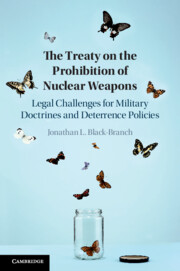 The Treaty on the Prohibition of Nuclear Weapons
The Treaty on the Prohibition of Nuclear Weapons Published online by Cambridge University Press: 17 April 2021
The adoption of the Treaty on the Prohibition of Nuclear Weapons (TPNW) at the United Nations General Assembly and its movement toward ratification raises both hopes amongst some and fears amongst others regarding the development of customary practice under international law. Although the TPNW purports to strive for universality, significant questions remain regarding the Treaty’s aims and achieving legal unity within the international legal order. The purpose of this chapter is to explore these and other issues regarding the TPNW’s prospects of achieving universality under customary international law and opinio juris.
To save this book to your Kindle, first ensure [email protected] is added to your Approved Personal Document E-mail List under your Personal Document Settings on the Manage Your Content and Devices page of your Amazon account. Then enter the ‘name’ part of your Kindle email address below. Find out more about saving to your Kindle.
Note you can select to save to either the @free.kindle.com or @kindle.com variations. ‘@free.kindle.com’ emails are free but can only be saved to your device when it is connected to wi-fi. ‘@kindle.com’ emails can be delivered even when you are not connected to wi-fi, but note that service fees apply.
Find out more about the Kindle Personal Document Service.
To save content items to your account, please confirm that you agree to abide by our usage policies. If this is the first time you use this feature, you will be asked to authorise Cambridge Core to connect with your account. Find out more about saving content to Dropbox.
To save content items to your account, please confirm that you agree to abide by our usage policies. If this is the first time you use this feature, you will be asked to authorise Cambridge Core to connect with your account. Find out more about saving content to Google Drive.